
Compass projects lower qualifying scores for the Class of 2027
The junior year PSAT is also the NMSQT — the National Merit Scholarship Qualifying Test. Each year, National Merit recognizes the top 57,000 test takers. In order to be included in that group, students need to be among the top 4% of the 1.4 million students who take the PSAT. Of that elite group, approximately 17,000 are recognized as Semifinalists for having the highest scores within their states. Semifinalists have the opportunity to continue in the program to become Finalists and, potentially, scholarship recipients. The remaining 40,000 students are recognized as Commended Students. More information can be found in our National Merit Explained post.
For the Class of 2027, the exact scores needed to qualify (“cutoffs”) will not be released until September 2026 (the Commended cutoff is likely to leak in April). In order to give students context for their test results, Compass has analyzed the scores from the October 2025 to produce estimates for the national Commended cutoff and the individual state cutoffs. We predict that the majority of state cutoffs will decline this year.
National Merit uses the Selection Index (SI), found on the PSAT score report, to rank students. The Selection Index can be calculated by doubling the Reading & Writing score (RW), adding the Math score (M), and dividing that sum by 10. For example, a student with a 720 RW and 700 M score has a Selection Index of 214 — (720 x 2 + 700)/10. The weighting of the index means that not all students with a 1420 Total Score have the same SI. A student with a 700 RW and 720 M has a Selection Index of 212. The highest SI a student can receive is 228 (760 RW and 760 M). Last year, the Commended cutoff was 210, and Semifinalist cutoffs ranged from 210 to 225 depending on the competitiveness of the state.
Why do we foresee lower cutoff scores?
College Board does not release any information about the distribution of Selection Indexes, but it does produce summaries of broad score ranges. The number of students in the 1400 – 1520 Total Score range has proved to be an excellent indicator of the Commended cutoff. The Class of 2027 saw 16% fewer top scores than did last year’s class. The 52,400 students at 1400 and above is closer to what we saw two years ago with the Class of 2025 and, going back further, similar to the results for the Classes of 2017 and 2021.
Most of the students who will qualify for National Merit recognition fall in the 1400 – 1520 band (or just outside it). With approximately 10,000 fewer students in the top band of scores this year, we expect the Commended level to drop to 208 or 209. The chart below shows the historical relationship between high scores and the Commended cutoff.
Explaining why last year’s cutoffs reached record levels
After examining this year’s numbers, we also have a better understanding of why Semifinalist cutoffs jumped to such extreme levels last year, and why it should not happen again. The 2024 PSAT saw an unprecedented 18% jump in the number of high Reading & Writing scores (700-760). The weighting of RW in the Selection Index magnified the impact of that change. The table below shows scores for the last three years and how results have fluctuated.
On the 2025 PSAT, the number of high RW scores dropped by 27%. In fact, the RW count for this year is even lower than it was two years ago. The decline in RW scores could even produce Selection Indexes lower than those in the Class of 2025 — at least in some states. The Commended cutoff may provide additional insight in the spring.
The ratio of 700+ M scores to 700+ RW scores reveals just how bizarre last year’s spike was. Traditionally, Math scores have higher distributions at the extremes. There are more very high Math scores on the PSAT and SAT, and there are more very low Math scores.
On the October 2024 PSAT, though, almost as many students scored 700-760 on RW as did on Math. The ratio of high Math scores to high RW scores was 1.02. This helps explain why some cutoffs went as high as 224 and 225 for the first time ever. Students achieved 750 and 760 RW scores in record numbers. In most years, there would be more students scoring 730 RW and 760 M (222 SI), for example, than scoring 760 RW and 730 M (225 SI). That was not true in the the Class of 2025, where there was a more equal distribution. It appears that scores for the Class of 2027 have returned to the traditional Math-heavy distribution. The ratio of high Math scores to high RW scores was 1.33 on the 2025 PSAT/NMSQT. For this reason, we don’t believe we will see a repeat of the 224 and 225 cutoffs seen last year.
Was last year a fluke, shift, or a trend?
The results from the Class of 2027 have answered one of the nagging questions from last year: Were the high cutoffs a fluke, shift, or trend? The answer appears to be fluke. More accurately, results could be labeled an error in test construction and scaling. There is no evidence that the Class of 2026 possessed special test-taking skills. As sophomores, that class performed in line with expectations on the 2023 PSAT. There is no evidence that the Class of 2027 has diminished skills. As sophomores, the class saw the same inflated scores as did the juniors on the 2024 PSAT. The best explanation is that College Board lost control of the scale. College Board dramatically shortened the PSAT when it switched from paper to digital. On the paper test, the Reading and Writing sections had 91 questions, and students were given 95 minutes. The RW on the digital PSAT is truncated to 54 questions over 64 minutes. And only 50 of the questions count toward a student’s score! A shorter exam means a less reliable exam. We saw the occasional wild ride on the paper PSAT, but the rides may get wilder and more frequent on the digital PSAT.
We anticipate the majority of state Semifinalist cutoffs to decline for the Class of 2027. Knowing this overall trend, however, doesn’t tell us which states will be in that majority or how much lower scores will go. The table below provides a Most Likely cutoff score, but the more useful information is the Estimated Range. Almost all cutoffs should fall within that range.
State | Class of 2027 (Most Likely) | Class of 2027 (Est. Range) | Class of 2026 (Actual) | Class of 2025 (Actual) | Class of 2024 (Actual) | Avg NMSFs |
|---|---|---|---|---|---|---|
| Alabama | 213 | 210 - 216 | 214 | 212 | 210 | 250 |
| Alaska | 214 | 210 - 216 | 215 | 214 | 209 | 35 |
| Arizona | 218 | 215 - 220 | 218 | 217 | 216 | 398 |
| Arkansas | 213 | 210 - 216 | 215 | 213 | 210 | 143 |
| California | 223 | 220 - 224 | 224 | 221 | 221 | 2,115 |
| Colorado | 218 | 216 - 221 | 219 | 218 | 216 | 286 |
| Connecticut | 222 | 220 - 223 | 223 | 221 | 221 | 175 |
| Delaware | 219 | 218 - 221 | 220 | 219 | 219 | 44 |
| Florida | 217 | 216 - 220 | 219 | 217 | 216 | 999 |
| Georgia | 219 | 217 - 221 | 220 | 218 | 217 | 602 |
| Hawaii | 218 | 215 - 220 | 219 | 217 | 217 | 62 |
| Idaho | 214 | 211 - 217 | 215 | 213 | 211 | 96 |
| Illinois | 220 | 218 - 222 | 222 | 220 | 219 | 704 |
| Indiana | 217 | 214 - 219 | 218 | 217 | 216 | 313 |
| Iowa | 213 | 211 - 216 | 214 | 212 | 210 | 145 |
| Kansas | 216 | 213 - 219 | 216 | 215 | 214 | 144 |
| Kentucky | 214 | 211 - 217 | 214 | 213 | 211 | 201 |
| Louisiana | 215 | 212 - 218 | 216 | 214 | 214 | 222 |
| Maine | 215 | 212 - 217 | 217 | 214 | 213 | 55 |
| Maryland | 223 | 221 - 225 | 224 | 222 | 221 | 308 |
| Massachusetts | 223 | 221 - 225 | 225 | 223 | 222 | 318 |
| Michigan | 219 | 216 - 220 | 220 | 218 | 217 | 485 |
| Minnesota | 218 | 216 - 220 | 219 | 217 | 216 | 279 |
| Mississippi | 213 | 210 - 215 | 213 | 212 | 209 | 155 |
| Missouri | 216 | 213 - 218 | 217 | 215 | 214 | 289 |
| Montana | 211 | 208 - 214 | 213 | 209 | 209 | 47 |
| Nebraska | 213 | 210 - 216 | 214 | 211 | 210 | 105 |
| Nevada | 214 | 211 - 217 | 214 | 214 | 211 | 168 |
| New Hampshire | 217 | 214 - 219 | 219 | 217 | 215 | 60 |
| New Jersey | 223 | 222 - 225 | 225 | 223 | 223 | 451 |
| New Mexico | 211 | 208 - 214 | 210 | 211 | 207 | 104 |
| New York | 221 | 219 - 223 | 223 | 220 | 220 | 1,012 |
| North Carolina | 219 | 216 - 221 | 220 | 218 | 217 | 510 |
| North Dakota | 210 | 207 - 212 | 210 | 210 | 207 | 30 |
| Ohio | 218 | 215 - 220 | 219 | 217 | 216 | 538 |
| Oklahoma | 212 | 208 - 214 | 212 | 211 | 208 | 204 |
| Oregon | 218 | 215 - 220 | 219 | 216 | 216 | 188 |
| Pennsylvania | 220 | 217 - 222 | 221 | 219 | 219 | 596 |
| Rhode Island | 217 | 214 - 220 | 219 | 217 | 215 | 47 |
| South Carolina | 214 | 210 - 217 | 215 | 214 | 209 | 236 |
| South Dakota | 210 | 207 - 213 | 211 | 208 | 209 | 42 |
| Tennessee | 218 | 215 - 219 | 219 | 217 | 217 | 319 |
| Texas | 221 | 218 - 222 | 222 | 219 | 219 | 1,623 |
| Utah | 212 | 210 - 216 | 213 | 211 | 209 | 196 |
| Vermont | 215 | 211 - 217 | 216 | 215 | 212 | 28 |
| Virginia | 222 | 220 - 224 | 224 | 222 | 219 | 437 |
| Washington | 222 | 220 - 224 | 224 | 222 | 220 | 348 |
| West Virginia | 209 | 207 - 212 | 210 | 209 | 207 | 64 |
| Wisconsin | 214 | 213 - 217 | 215 | 214 | 213 | 292 |
| Wyoming | 209 | 207 - 212 | 210 | 209 | 207 | 24 |
| District of Columbia | 223 | 222 - 225 | 225 | 223 | 223 | 36 |
| Territories | 209 | 207 - 211 | 210 | 208 | 207 | 39 |
| Outside US | 223 | 222 - 225 | 225 | 223 | 223 | 86 |
| Commended | 209 | 207 - 210 | 210 | 208 | 207 |
How cutoffs are determined
Qualifying scores (“cutoffs”) are not based on the total score for the PSAT (360-1520) but on the Selection Index, which is calculated by doubling the RW score, adding the Math score, and then dividing the sum by 10. The maximum Selection Index is 228. Students can find a historical set of cutoff data here or see how Semifinalist and Commended counts have changed state by state.
We estimate that the Semifinalist cutoffs will range from 209 to 223. Semifinalists are allocated by state, and cutoffs are calculated by state. If Florida is allocated 1,000 Semifinalists based on its population of high school graduates, then NMSC works down from a perfect 228 Selection Index until it gets as close as possible to that target. Last year, 1,008 students scored at or above the cutoff of 219. A cutoff of 220 would have produced too few Semifinalists. A cutoff of 218 would have gone over the allocation. Because score levels can get crowded, it is easy for cutoffs to move up or down a point even when there is minimal change in testing behavior or performance.
Why does each state have its own Semifinalist cutoff if the program is NATIONAL Merit?
This is always a hot button question. NMSC allocates the approximately 17,000 Semifinalists among states based on the number of high school graduates. That way, students across the nation are represented. It also means that there are very different qualifying standards from state to state. A Massachusetts student with a 220 might miss out on being a Semifinalist. If she lived 10 miles away in New Hampshire, she would qualify.
No Semifinalist cutoff can be lower than the national Commended level. Cutoffs for the District of Columbia and for U.S. students studying abroad are set at the highest state cutoff (typically New Jersey). The cutoff for students in U.S. territories and possessions falls at the Commended level each year. Boarding schools are grouped by region. The cutoff for a given region is the highest state cutoff within the region.
Change is always the theme
Over the last two decades, at least half of the state cutoffs have changed each year. In some years, as many as 49 states saw ups or downs, usually because of questionable test forms. In addition to last year’s exam, the PSATs from 2011 (Class of 2013), 2016 (Class of 2018), and 2019 stand out as problematic. The anomalous 2019 results could be traced back to a particularly mis-scaled form, which I wrote about at the time. The Class of 2014 also saw significant changes, but those were more of a bounce-back from the previous year. The question for the Class of 2027 is how much of a bounce-back will be seen this year.
Cutoffs are particularly bumpy in states with smaller pools of test takers and National Merit Semifinalists. Over the last dozen years, cutoffs in the 12 largest states have remain unchanged 36% of the time, while the cutoffs in the smallest states have remain unchanged only 1 time out of every 5. No large state’s cutoff has jumped by more than 3 points in a year, whereas 6-point changes have occurred in the pool of smaller states.
When are National Merit Semifinalists announced?
The lists of Semifinalists will not be distributed to high schools until the end of August 2026. With the exception of homeschoolers, students do not receive direct notification. NMSC asks that schools not share the results publicly until the end of the press embargo in mid-September, but schools are allowed to notify students privately before that date. NMSC does not send Commended Student letters to high schools until mid-September. Compass will keep students updated on developments as the dates approach.
Do state and national percentiles indicate whether a student will be a National Merit Semifinalist?
No! Approximately 1% of test takers qualify as Semifinalists each year, so it is tempting to view a 99th percentile score as indicating a high enough score — especially now that College Board provides students with percentiles by state. There are any number of flaws that rule out using percentiles as a quick way of determining National Merit status.
- Percentiles are based on section scores or total score, not Selection Index
- Percentiles are rounded. There is a large difference, from a National Merit perspective, between the top 0.51% and the top 1.49%
- Percentiles reveal the percentage of students at or below a certain score, but the “at” part is important when NMSC is determining cutoffs.
- The number of Semifinalists is based on the number of high school graduates in a state, not the number of PSAT takers. Percentiles are based on PSAT takers. States have widely varying participation rates.
- Most definitive of all: Percentiles do not reflect the current year’s scores! They are based on the prior 3 years’ performance. They are set even before the test is given. And if you are going to use prior history, why not use the record of prior National Merit cutoffs rather than the highly suspect percentiles?
Entry requirements for National Merit versus qualifying for National Merit.
Your PSAT/NMSQT score report tells you whether you meet the eligibility requirements for the NMSP. In general, juniors taking the October PSAT are eligible. If you have an asterisk next to your Selection Index, it means that your answers to the entrance questions have made you ineligible. Your answers are conveniently noted on your score report. If you think there is an error, you will also find instructions on how to contact NMSC. Meeting the eligibility requirements simply means that your score will be considered. Approximately 1.4 million students enter the competition each year. Only about 55,000 students will be named as Commended Students, Semifinalists, Finalists, or Scholars. See National Merit Explained for more information.

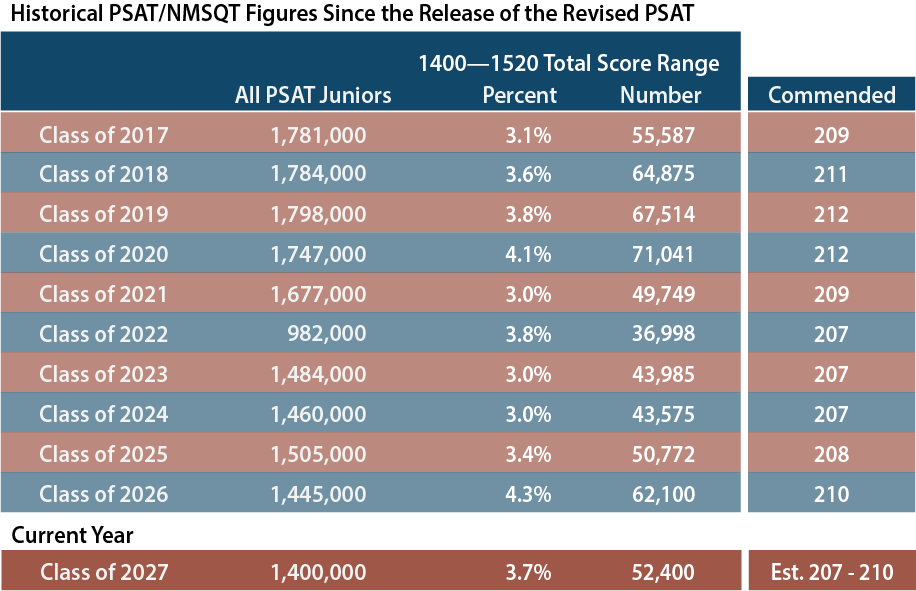
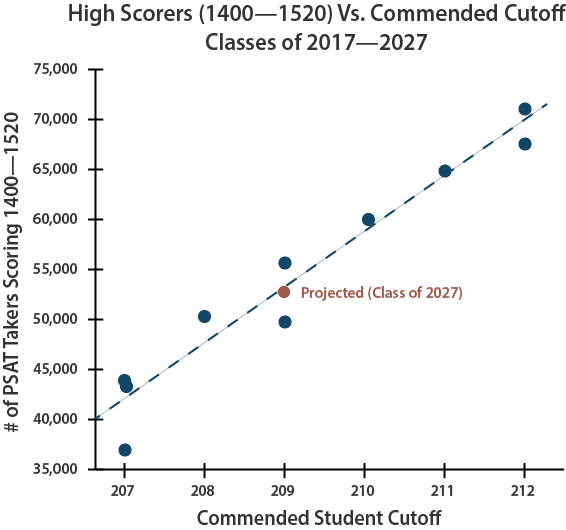


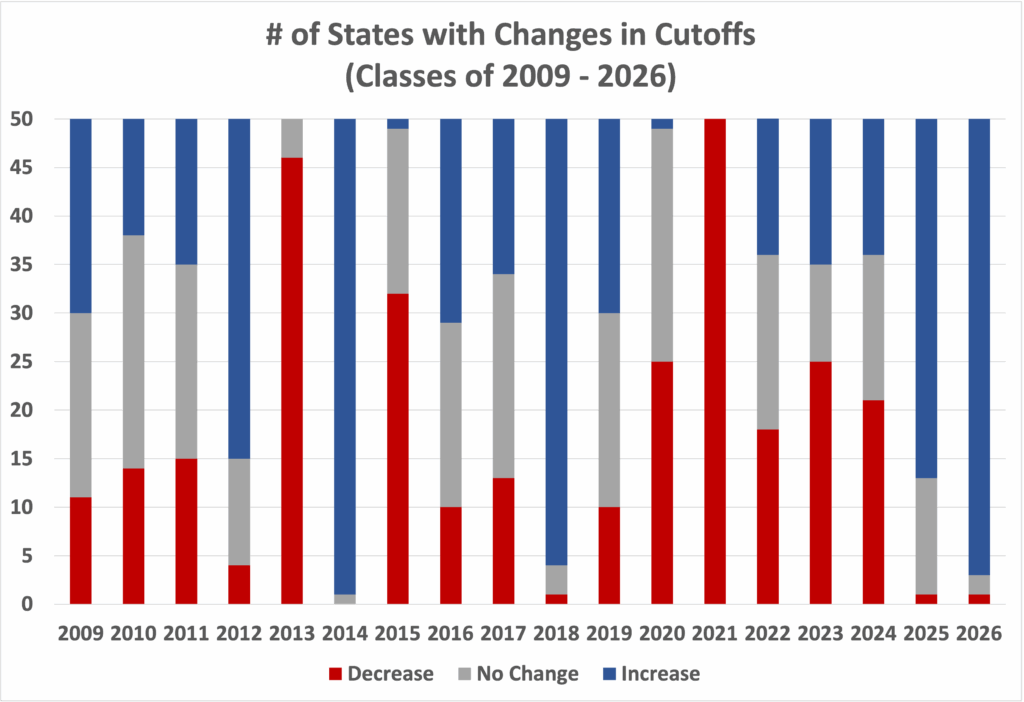
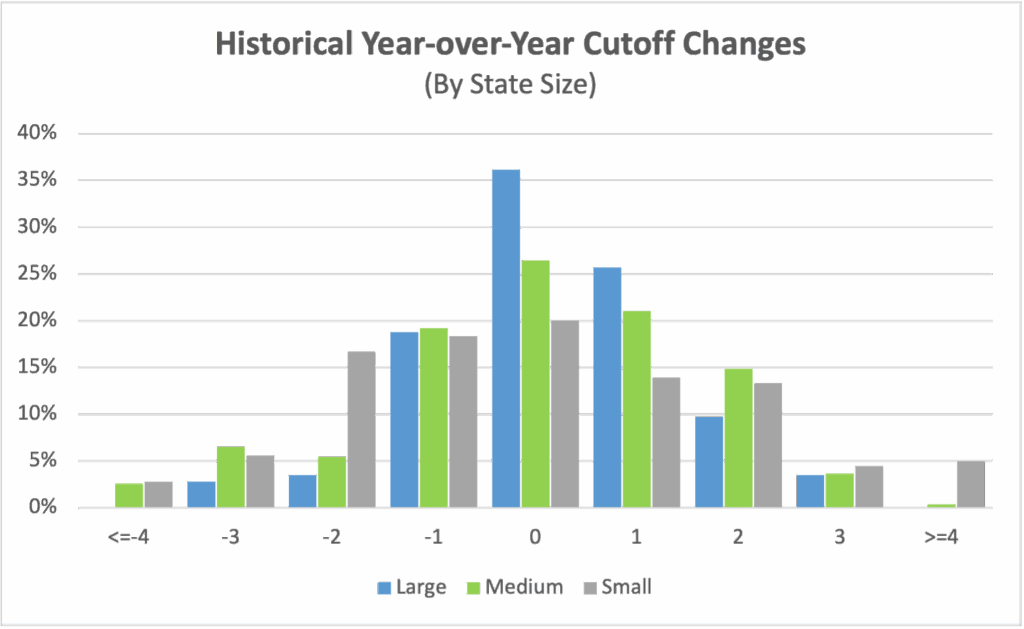
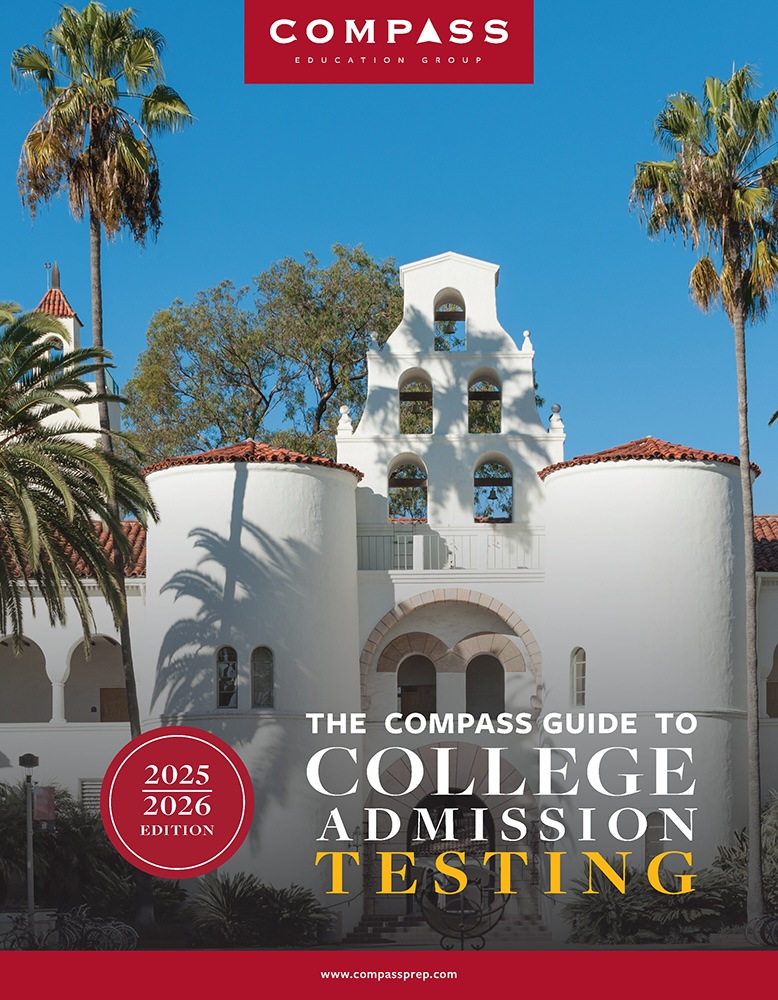
Hi, thanks for your insightful analysis! My son made 222 in California, are we certain he is going to make semifinalist?
John,
I’m firmly optimistic that he’ll make Semifinalist. I rate that as just below “confident,” which ranks just under “certain.” Even with this year’s weak scores, I can’t bring myself to take 223 off the table as a remote possibility.
Hi Art, I got 218 in New York state. Do you think there’s a possibility of making semi-final list? Thank you so much for the article and response.
SM,
While New York has had a 218 cutoff in the past, it’s been a decade since it happened. I did include the possibility in my estimated range, because (a) it has happened and (b) we are seeing a weak year. I’ll admit that the odds are fairly low.
Do you think 219 has a chance in New York?
MT,
While we don’t know that NY will have a low year, we do know that in other weak years New York has seen cutoffs of 220, 220, and 219. So, yes, I think 219 has a chance.
Hello!
I wanted to begin by thanking you very much for this thorough update. I, as well as many other anxious students and parents, so greatly appreciate it.
Now for my question: Do you anticipate CT’s rise to a 223 cutoff? I have scored a 222, which I know you have at the high end of your range, but still cannot help but feel nervous about a jump-up.
I would love to hear your thoughts and thank you in advance for providing them!
BN,
It sometimes feels that NMSC designed the process for maximum anxiety. The good news for you is that Connecticut has always finished just below the highest state cutoffs. If we were seeing a blockbuster year, I might feel differently, but I don’t see a 223 cutoff in Connecticut.
Hi Art,
Thank you so much for your time and patience writing such a great article and answering all of these questions!
My daughter received a 221 in CA. I know this is on the low end of the ‘bubble’, but I was wondering how virtual schooling might affect the CA numbers. Much of the state (including my daughter’s school) did the entire year at home.
Thanks again!
Christie,
Yes, it’s possible that we are seeing lower scores this year because of the challenging learning environment. Online learning was more prevalent in California than in most states, so the national numbers might not reflect our state. Unfortunately, we are unlikely to have enough visibility over state results to predict how things play out.
Hello Art,
Would a 1480 in Minnesota suffice for NMSQT?
Thanks!
Sincerely,
A student who doesn’t wish to disclose their identity
Anon,
A total score can convert into different Selection Indexes depending on the split between ERW and Math. A 740/740 would be a 222 SI, but a 720/760 would be a 220 SI. I think Minnesota will likely come in around 219, but no higher than 222.
Here in NJ. Am I calculating this right?- 1500 (750/750) so index of 225? Based on your estimates, son should meet the cut off, right?
Either way, so proud!
EJ,
You are correct on all 3 counts: 225, Semifinalist qualifier, proud parent.
What are the chances Delaware rises to 222?
Anon,
Small states always concern me, but Delaware has only risen to 222 once, and that was in a year when the Commended was 212.
What is your prediction for DC ? A repeat of last year ? Also wanted to confirm that the national numbers included all the states because some of them are being released today .Thank you for the wonderful blog – it is easiest one I have come across that has helped me understand this plethora of tests .
M,
The scores were available to counselors last week. It’s possible, of course, that more were added, although we’ve still got the 3% figure for the proportion of students getting 1400 or higher. It’s not a blockbuster year.
DC gets no say in the matter, since it’s tied to the highest state. I don’t think we’ll see another Alternate Entry meltdown, but I don’t know that for sure. I estimated a 223 because it’s possible that one of the top states will get there. It’s something of a toss-up between 222 and 223.
I’m glad we could help!
How safe do you think a 220 is in NC?
NW,
Very. North Carolina would need to set a new record and do it during a year when high scores seem in short supply. Not impossible, but I’d lay heavy odds against it.
Hi Art
My son has a 223 selection index. We are in NJ. He is in the most likely in your chart. Does he have a good shot at National merit?
SF,
He has an excellent shot. Even in up years we haven’t seen NY reach 224. I’m a little concerned about Alternate Entry based on Maryland’s experience last year, but it’s highly unlikely in NJ.
Art,
Thank you so much for your insight on the Merit Scholarship information. It has been very eye-opening and I have learned a lot. My daughter scored a 213 in Alabama. I noticed your prediction for the 2023 class is 214. Do you think she still has a chance? I really appreciate all that you do for parents and students.
Thank you for your time,
Sarah
Sarah,
I consider anyone within my estimate range to have a chance. Even a 211 is not out of the question, but I think 212-215 is even more likely.
Hi Art,
My Selection Index score on the PSAT is a 204. I received a 1390, and my score report says that I am 99th percentile. Is it likely that I will get commended due to this 99th percentile? My selection index is awfully low, but my percentile is making me think that I have a shot at commended. I’m also worried about the accuracy of my percentile, because a 1390 usually corresponds to the 96th percentile.
Thank you for all of your information on the National Merit Cutoffs!
LS,
The default percentiles on the College Board reports are “Nationally Representative.” That’s a strictly hypothetical number based on every student in the country — even those not going to college — taking the PSAT. More important, percentiles are based on the three prior years’ data rather than on the current year. For the purpose of predicting National Merit, they are terribly misleading. I’m afraid we won’t see a Commended level drop to 204.
Hi Mr. Art Sawyer,
I have a few questions in response to this post:
1. If there is another Alternate Entry situation, when would they likely announce it and what would you say is the likelihood of this occurring?
2. Would an SAT taken in October 2021 be acceptable as an alternate entry for the class of 2023?
3. Should I feel pretty confident in qualifying as a semifinalist with a PSAT score index of 223 in Maryland?
4. If there is another Alternate Entry mess in MD, would a 1550+ on SAT probably suffice to making the semifinalist cutoff?
Thanks so much, I really appreciate all of the help your resources have been providing me!
David,
1) I’m going to beg off answering this one. Predicting what NMSC decides is outside of my scope. I’m encouraged by the 1.5 million PSAT takers.
2) Yes, but not applicable if you have a PSAT score.
3) Yes. You probably know more than I do about how well Maryland schools were able to pull off the PSAT this year. I would imagine that there is a wide gulf between this year and last. I don’t see Maryland reaching 224 based on PSAT scores alone.
4) To clarify, if you have a PSAT score, Alternate Entry does not apply. The “mess” last year revolved around the sheer number of students who didn’t have PSAT scores.
Good luck!
Thank you so much for this tremendously helpful analysis. I see you have SC with a “most likely” of 215. If commended is 208, that would put SC’s semifinal cutoff at 7 points above commended which hasn’t happened at least since 2017. If commended turns out to be 209, then at 215 we’d be 6 points above commended which has happened 3 times in the past 6 years. We’re nervous but hopeful that 214 will be enough.
JB,
Nervous but hopeful describes about 90% of my readership (and fits me, too), so you and your student have company. Good luck!
Hi Art, your information is so helpful, thank you. My son scored a 217 in New York, so it sounds like he’ll just miss the semi-finalist cutoff, but is there any possibility that won;t qualify as a commended score? Thanks!
He is guaranteed to at least qualify as a Commended Student. His score will be well above any possible cutoff.
Hi,
Do you know the cut off for Kentucky?
Su,
Cutoffs do not become known until September. For now, all we can do is estimate them. Kentucky has seen wide swings in the past, so I estimate the range as between 212 and 218. A 215 or 216 has a good chance of qualifying this year, in my opinion.
Any real chance a 218 makes the semifinalist cutoff in Oregon?
Your range goes down to 217, with a likely of 220, but the >1400 percentile for this year seems to match the class of 2021 where Oregon then went to a 217 cutoff?
A L,
Yes. As you say, Oregon has had a 217 cutoff in a down year. The other classes with low numbers of high scorers saw Oregon at 219 and 220, but I think we need to discount that 220 because of Alternate Entry. National percentiles don’t always align with state numbers. If they did, I wouldn’t need to report ranges at all.
Hi Art,
We live in New York and my daughter has a 221 selection index, which you have as your most likely. Since this is an increase from the past 2 years actual, is it fairly conservative? Do you see any scenario in which NY goes to 222?
Thanks!
Hal,
Looks like you caught the table before I uploaded by correct version — the one developed in tandem with the Commended score analysis. Now that we think things look weak nationally, I’ve got my Most Likely at 220. In low-Commended years, New York has been at 219, 220, and 220. That’s no guarantee that it won’t go to 221. A move to 222 would require something extremely unusual to have happened. It’s been more than a decade since New York came within a point of New Jersey. It will likely fall into the group of states just below those with the highest cutoffs. Your daughter’s chances look good.
I got a 213 with a 1390, and I’m in New Mexico—do you think I have a chance to qualify as a semifinalist?
Marly,
New Mexico has seen a lot of movement over the years. Recently, a 213 would have qualified in 4 of the last 6 years. The two exceptions were in years where the Commended fell much higher than we expect it to come in this year. You’re in good shape, but close enough to where you’ll need to wait until September for any certainty.
Hi Art! Thanks for your well-reasoned analysis and predictions! My son has a 222 in Massachusetts, which I see is your predicted cutoff. How likely do you think it holds there/how are my son’s odds? Thanks again!
MT,
It’s hard to predict the top scores (and MA is usually #1 or #2). The weak numbers nationally make me think we are slightly more likely to see a 222 than a 223, but anyone claiming that they know which way it will end up is kidding themselves. We’ll all be watching things carefully come August.
My son got a 226 SI index in California. Is it likely that he will become finalist? Thanks.
lb,
It’s a lock for Semifinalist. Once that is announced in September, he’ll apply to be a Finalist (most students make it). For more information, see this pamphlet for the class of 2022.
Hi Art,
Thank you very much for your time and patience in writing such a great article and
answering all the questions!
My kid scored a 221. Do you think a 221 in Texas might make it to a Semifinalist?
Thanks in advance.
SM,
I think it’s very likely. I don’t see Texas moving up to a 222 in what looks to be shaping up as a low-scoring year for the PSAT.
Hey Art!
I just checked my score! How much of a chance is a 220 in Georgia looking at?
Thanks
James.
I don’t think we can say it’s a lock, but the probability of a large state hitting a record high in a “down” year is very low. I don’t think Georgia will go above 220.
Hi Art, thanks for your insight and helping us out here! My son received a 219 in Texas, I understand that its at the lower-end of the range and 220 is most likely. With 219 as cut-off for class of 2021, how likely is that 219 can happen again in Texas?
RS,
In what I’m calling the “low” years, Texas has come in at 219, 220, and 220. That falls in line with my thinking this year — maybe a higher chance of a 220 than a 219, but we can certainly see it come in at the lower figure.
Hello — I’m wondering how the “most likely” for the District of Columbia can be 223 when the highest for any other state is 222 (NJ/MA). I thought DC’s cutoff was the same as for the highest state. Thanks
Mary,
I was sort of hoping that someone would call me out on that. Here is my thinking: If I am a 222 student in Massachusetts, I just need my state not to stick below 223. If I’m a student with a 222 SI in DC, however, I need EVERY state to stay below 223. Four states have hit 223 in the past, and there is always the potential for a “Maryland surprise.” There is a good chance that a 222 will qualify in DC, but the 223 recognizes that pandemic-era testing is… interesting.